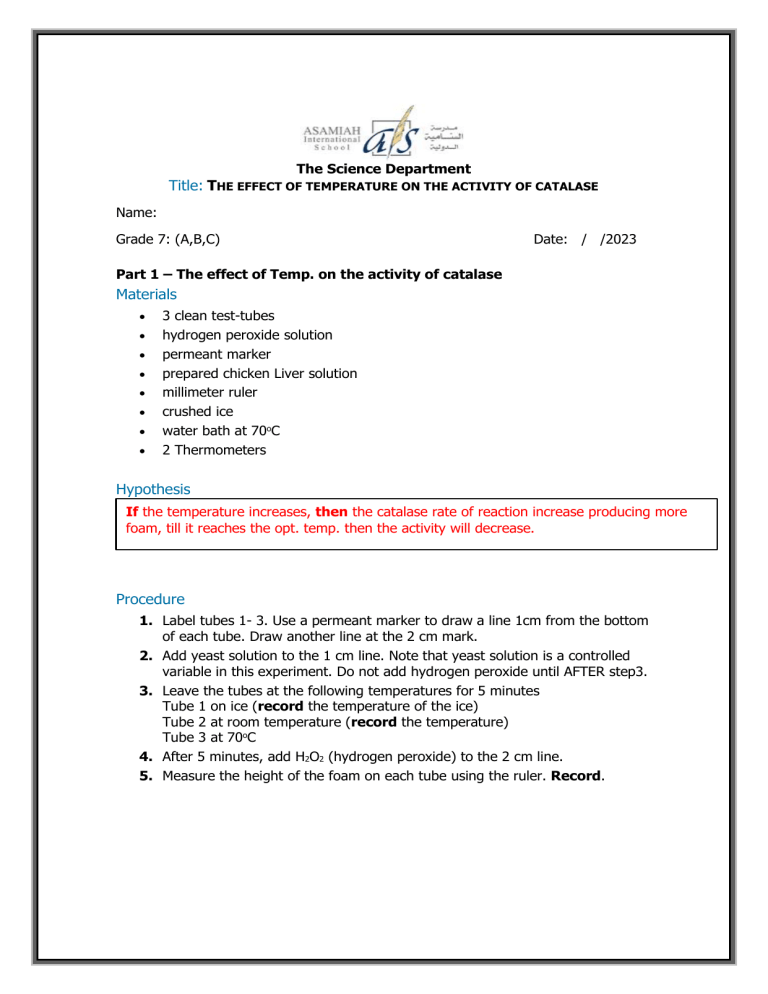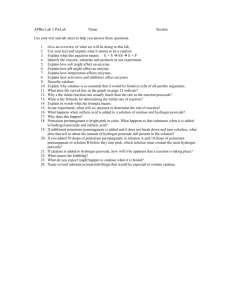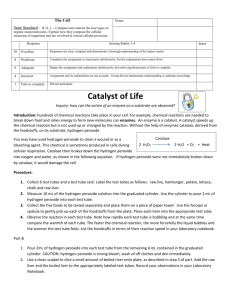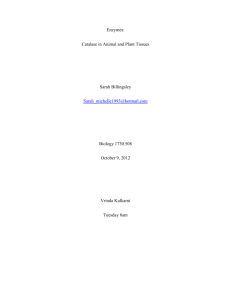
The Science Department Title: THE EFFECT OF TEMPERATURE ON THE ACTIVITY OF CATALASE Name: Grade 7: (A,B,C) Date: / /2023 Part 1 – The effect of Temp. on the activity of catalase Materials 3 clean test-tubes hydrogen peroxide solution permeant marker prepared chicken Liver solution millimeter ruler crushed ice water bath at 70oC 2 Thermometers Hypothesis If the temperature increases, then the catalase rate of reaction increase producing more foam, till it reaches the opt. temp. then the activity will decrease. Procedure 1. Label tubes 1- 3. Use a permeant marker to draw a line 1cm from the bottom of each tube. Draw another line at the 2 cm mark. 2. Add yeast solution to the 1 cm line. Note that yeast solution is a controlled variable in this experiment. Do not add hydrogen peroxide until AFTER step3. 3. Leave the tubes at the following temperatures for 5 minutes Tube 1 on ice (record the temperature of the ice) Tube 2 at room temperature (record the temperature) Tube 3 at 70oC 4. After 5 minutes, add H2O2 (hydrogen peroxide) to the 2 cm line. 5. Measure the height of the foam on each tube using the ruler. Record. Tube Number Temperature 0C Height of foam (mm) 1. 2. 3. Results Prepare a line graph of catalase activity as influenced by temperature. Analysis 1. Did the results support the hypothesis? Answer yes / no depending on your results 2. Identify the dependent, independent variables in the experiment. Catalase in different temperatures/ Independent The amount of foam formed (height in mm)/ Dependent 3. List 2 controlled variables in the experiment. The amount of liver solution (amount of catalase) The concentration of Hydrogen peroxide H2O2 Measure the foam’s height after 5 minutes 4. Evaluate the validity of the method based on the outcome of the investigation. If a method measures what it claims to measure, then it can be considered valid. In this investigation the method was valid as it measured the effect of temperature on the activity of catalase. I followed each step and made sure that I didn’t miss anything out. I controlled things like making sure my glassware was clean for each trial. I kept the temperature monitored during the trials by using a thermometer per each water bath. I left the liver solution and the hydrogen peroxide in the water for the same time each trial at each temperature. 5. State improvements or extensions to the method that would benefit the investigation. Are there flaws in the procedures used which could affect the result? Were important variables not controlled? Are the measurements and observations reliable? Part 2 - Design an Experiment Lactaid is a product designed to help people who cannot digest milk sugar (lactose) because they are missing the enzyme lactase. Many people are lactose-intolerant, a condition that is mainly genetic. Lactase breaks down lactose into two subunits: glucose and galactose. To test for the presence of monosaccharides and reducing disaccharide sugars in food, the food sample is dissolved in water, and a small amount of Benedict's reagent is added. The solution should progress in the colors of blue (with no glucose present), green, yellow, orange, red, and then brick red when there is a large amount of glucose present. Design an experiment where you would determine how quickly Lactaid works to break down milk sugar at different temperatures. Be specific in your description, use drawings if necessary.





